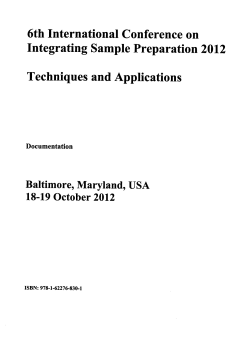
Disease Magarey Burdekin research meeting 3.15
Biosecurity research – protecting our future Rob Magarey Sugar Research Australia Strategy Endemic pests and diseases – Long history of BSES / SRA research • Identifying threats and developing management options Ongoing and largely successful Exotic threats – Constant presence • Whenever a mill area grows 60% + area to one variety – An epidemic usually occurs – Some of these are exotics Strategy SRA has taken a proactive stance • • Don’t wait for the ‘horse to bolt before shutting the gate’ Do the research off-shore – Collaborate with overseas scientists » Draw on their expertise » Work together to undertake needed research Strategy Since the 1980s • BSES (SRA) worked with the PNG sugarcane industry / other countries • Major consultancy agreements with PNG from the early 1980s • More recent times, collaborated with Indonesia – ACIAR-funded projects Strategy Aims • Detection / identification • Management strategies • Resistance of our varieties • Experience in working with threats Recent Indonesian research – ACIAR-funded Focus • Stem-borers – • IPM strategies (parasitoids) Sugarcane streak mosaic virus (SCSMV) – Epidemiology (transmission / spread) – Identification Main threats to Australia Mosaic – Photos of mosaic • SCSMV ACIAR project - Indonesia – 5 year project: 2008-2012 Trichogramma – egg parasitoid Staff • 4 ‘Australian’ entomologists • 1 extension / business officer • 1 publications person • 2 pathologists Indonesian scientists • Pathologists / entomologists / extension – Total budget: $530,200 – Federal Government funding ACIAR project - Indonesia Main targets Moth borers: » Chilo sacchariphagus » Chilo auricilius » Scirpophaga excerptalis Sugarcane streak mosaic virus Indonesia research Main outcomes Moth borers: – Defined their distribution across Java • (931 crops surveyed) – Showed that the current IPM strategy is ineffective • But would be effective if Increased the dose of Trichogramma – Learnt more about life cycle / yield loss – Developed extension materials 1.5 cm Trichogramma on borer egg mass Indonesia research Main outcomes SCSMV: – Important in Indonesia • perhaps our greatest threat – Possibly spread by cane knives – Rapid spread – Not eliminated by HWT Indonesian pest and disease field guide Conclusions Main outputs • SRA staff gained experience with exotic pests and diseases • Most important exotic threats identified • Control measures researched / refined • Extension materials produced New Indonesian ACIAR project • Sugarcane streak mosaic virus – project 2 – Worth close to $1 m – 2015-2019 Sugarcane streak mosaic virus In SE Asia • Different strains and viruses cause mosaic – Some have greater yield effects • and have different transmission properties • Emerging disease: sugarcane streak mosaic virus Main aims • Distribution of SCSMV around Indonesia • SCSMV epidemiology – speed of spread / build up • Resistance testing • Methods • Australian variety ratings • Define yield losses • Rapid cheap detection method • Effective IDM strategy Sugarcane streak mosaic virus • Institutions involved – Indonesian Sugar Research Institute – Bogor Agricultural University – Indonesian Sweetener and Fibre Crop Research Institute – Sugar Research Australia • First project meeting in April Project 3: PNG research • Long history under BSES / Ramu consultancy – 1982 to now • In 2009, collaborative research – funded by SRDC / SRA • Institutions – Sugar Research Australia – Ramu Agri-Industries • Important threats in PNG – Stem borers – Downy mildew (DM) – Ramu stunt Project objectives • Resistance tests • Sesamia grisescens, • downy mildew, and • Ramu stunt • • particularly rapid testing Diagnostic tests • downy mildew and Ramu stunt • Pathogen variation with the diseases • Update incursion management plans (2009-2015) Field trial resistance research Sesamia grisescens (Nader Sallam) • Indication of the ‘resistance’ of Australian commercial varieties gathered • ‘Resistance’ to Chilo terrenellus • Rapid shade-house testingc DM (Rob Magarey) • Focus is rapid resistance screening • Field trials with the latest Australian commercial varieties Ramu stunt (Rob Magarey • Field trial planted in 2014 with latest varieties Downy mildew pathogen research DM pathogen variation (Nicole Thompson) • Surveys suggest 3 taxa of Peronosclerospora are causing DM • taxa more closely aligned with P. sacchari and P. miscanthi rather than P. philippinensis • Further work to confirm these variants • Pathogen variation vs resistance? Ramu stunt research • (Kathy Braithwaite) Pathogen is a Tenuivirus • • Pathogen variation seen around PNG in survey samples • Researched where to sample plants Future • Current project finishes 1 May 2015 • New project submitted to SRA • Complete rapid DM test development • Sequence Tenuivirus • Completion of DM pathogen variation / assay work • Resistance screen 2 other borers • • Scirpophaga excerptalis / Chilo terrenellus 2-year project finishing 30 June 2017
© Copyright 2024













